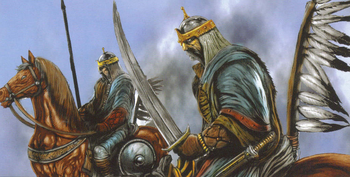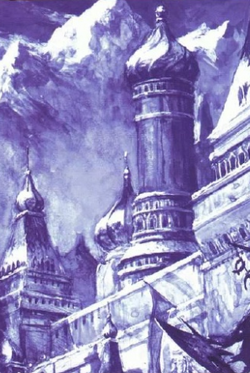"It’s believed that the Kislevites are actually descendants from this race. Ancient records and carvings suggest the Kislev tribe travelled south and west, perhaps fleeing some other threat, much in the same way that many of our ancestors drifted west through the Black Fire Pass. Evidence of their Kurgan heritage still manifests itself in the northern reaches of Kislev, mirroring many of the customs and practices of the Dolgans and Khazags. The northern Kislevites have strong nomadic tendencies and see their southern cousins as weakened, maybe even tainted, by the decadence of the Empire."
- —Ansel Shopenhauer, Imperial Diplomat.[2a]

The Great Gospodar, Conquerors of the Eastern Steppes.
The Gospodars are a tribe of nomadic Humans that once claimed a mighty Kingdom within the Eastern Steppes before migrating towards the lands of Kislev, making them the ancestors of the modern day Kislevite and the descendants of the ancient Scythians of old. Almost all of the ruling elite, including the Tzars and Tzarinas, come from Gospodar stock, and their language and beliefs dominate Kislevite society. In particular, the Gospodar Cult of Ursun the Bear is the most powerful religion in Kislev, influencing even most Ungol communities. Gospodar women, who are renowned throughout the Old World for their fair-skinned beauty, are afforded the same rights as men, which can be confusing to outsiders unfamiliar to such equality.[1b]
The Gospodars are a tall, imposing folk with fine features that can seem exotic and strange to foreigners. Indeed, for the Gospodar were once a branch of the now Chaos-worshipping Kurgans of the East, before they made their migration to the west to escape Chaotic enslavement. Their skin is usually pale, though those wandering the oblast will be as weathered as any Ungol tribesman, and their often-straight hair ranges from blue-black to reds and blondes. Some blessed babies are born with white or silver hair, which is believed to be a sign the land’s spirits have marked the child for great deeds.[1b]
History
Since before its founding, the people that would found and rule Kislev were the ancient clans of the Gospodar, a mighty nomadic people of the Eastern Steppes and the descendants of the ancient Scythians of old. They lived, drank, loved, and died like their fore-fathers before them, living out their lives in relative peace upon the open steppes. All that changed the day Chaos began to flow like water unto the cold Harsh lands of the uppermost north, and foul foes and numberless beast of all kind began to stalk and kill off their people. The mighty Gospodars and their former brethrens and neighbours, the Hung and Kurgans, fought on against the wills of the Chaos Gods, for no sane Human being would willing give up their souls to damnation. But such a foe could not be so easily stopped and in time, one by one, their former neighbours were subdued and were enslaved into their worship. Though their brethrens were mighty and fierce, they lacked the will power of the Gospodars to fight on, and so the Gospodars kept on fighting, ever believing in the divinity of their Gods, and requesting their aid against them. The greatest of their god, Ursen, God of Bears and Strength, aided his people in their time of need, but even his godly strength and will of arms proved insufficient, and slowly but surely, the Gospodars plight was desperate.[1a]
Then a great spirit called "The Ancient Widow," "Kislev" or simply "The Land" whispered to a Gospodar shaman-priestess. The spirit promised her great power if she swore to lead her people West, towards a distant, frozen realm where the spirit was trapped by the will of the Dark Gods. The shaman, desperate to aid her people, readily agreed and was granted the ancient and mystical power of Winter itself. With the Ancient Widow's guidance, the shaman quickly mastered her new and god-like powers and used them to gather what she needed to fulfill her promise. With her will-power and powerful magic, she bound the disparate Gospodar Clans into a single unified people and placed herself above them as their first Khan-Queen.[1a]
With her people united and determined, the massive horde of horsemen raced across their now dying homeland, riding all their hardest to escape the darkness that has come to consume them all. After many long years of bloodshed and sacrifice on the Endless Steppe, the now war-driven people of the Gospodars finally reached the mighty Worlds Edge Mountains, the final barrier that bars the way from her peoples destiny. Once Khan-Queen Miska reached the other side, there, wide-eyed, she encountered a vast snow-covered plain pulsing with mystical icy power. She immediately collapsed to the ground and wept frozen tears, for she knew the search for her peoples salvation was finally over.[1a]
The Great Conquest of Kislev (1497 IC to 1524 IC)
Though the great spirit promised this beautiful snowy paradise to the Gospodars, the land was already claimed by another group of horse-born people. The Ungols of ancient times had lived in this lands for centuries, having fought and bleed their blood and the blood of their sons to halt the Greenskin menace that invaded the Old World during the reign of Sigmar Heldenhammer. Though peace between the Ungols and Sigmar's people were solidified during the Battle of Black Fire Pass, this peace did not transfer towards these new invaders. Though these were powerful tribes, the people of the Ungols of Kislev, or the Udoses and Ostagoths of the Empire could not hope to stand in the way of the Gospodar horde that pours out of the north.[1a]
Under the leadership of Khan-Queen Miska, the Gospodars were powerful and wealthy and possessed of an unmatch genius in warfare, their skills in fighting from horseback superior to that of even the Ungols. The Khan-Queen was not only a warrior of great skill and courage, but also a powerful sorcerer of unmatched power. Soon, the Ungols were pushed back and scattered, with the Ungols having an ever-lasting fear of the dreaded "Ice Queen". The Khan-Queen continued her march of conquest against the Ungol tribes for several years, eventually leading her host towards the walls and gates of the Ungol bastion of Praag itself. Though mighty and powerful, the walls of this ancient city was laid low by the powerful icy spells of the Khan-Queens magic, forcing the entirety of the Ungol people westward towards their new capital city of Norvad.[1a]
With the sudden dislocation of their native homeland, the Ungols migrated towards the northwest, forcing their way into Roppsmenn territory. All previous alliances and treaties between these two people ended when Praag fell, and an Ungol army under the leadership of Warlord Hethis Chaq defeated a Ropsmenn host led by their ruler, King Weiran on the cliffs overlooking the Sea of Claws. With the death of their ruler, the Ropsmenn tribes were scattered, and the Ungols claimed their former neighbors lands and absorbed the remnants of this once great people.[1a]
The Founding of a Kingdom (1525 to 2301 IC)

The Birth of a Nation.
Not content to keep and cultivate the lands they have earned during their conquest, the Gospodar tribes began to further expand their territories westward until they came into conflict with the provinces of Ostland and Ostermark. Torn with strife and constant warfare during the Age of the Three Emperors, the Men of the Empire were not strong enough to halt the advance of the Gospodar horsemen as they drove deep into unoccupied territory. Soon much of the northern territories of Ostland was lost, until finally the Gospodars had to halt their advance at the edge of the Forest of Shadows.[1a]
Though the lands the Gospodars claimed were won back by the military might of the Imperial Armies, the status and power of the Gospodars eventually made the Empire consider their claims as a Kingdom in its own right. Khan-Queen Miska did not live to see the land she had begun to forge take shape, for she vanished into the north, claiming to have seen a vision of a terrible furture where she would once again be needed to lead her people to salvation. Leaving her fearsome magical warblade, Fearfrost, to her daughter Shoika, Miska gathered her most trusted warriors and rode north, never to return. By the year of 1527 IC, the Gospodar tribes under the rulership of their new Khan-Queen began construction of their great capital city, which they named Kislev, after the land and kingdom itself. With the city of her people in construction, Shoika removed her previous title as Khan-Queen and accepted her new title as Tzar to indicate her new reign over the lands north of the Urskoy.[1a]
Under the new rulership of Tzarina Shoika, the city that was to become Kislev was built, and the realm began to take shape into the nation it was today. Having inherited the title as the new Tzarina of Kislev, the Gospodarin Calendar and the establishment of the nation of Kislev was founded under her edict. Her first act as Tzarina was to march on towards Norvard, the last bastion of Ungol resistance against Gospodar dominance. This mighty trading port on the western coast of Kislev, proved to be the key in placing Kislev at the forefront of trade with the rest of the world, and Shoika knew that her dreams of a unified nation will not be fufilled, whilst the city is still held under enemy hands. Leading her host through the open tundra of Northern Kislev, her host of warriors began a new campaign to solidify their hold on the northwestern territories. Less than two years after her crowning as Tzarina, Shoika and her host of horsemen eventually besieged and captured the capital city of Norvard, renaming it Erengrad, in honour of the victory. Those Ungols that survived the bloody siege fled to the north, where they were ruthlessly hunted until finally their people had no choice but to accept the Gospodars rule over the land and assimilate into Gospodar society.[1a]
With this final act, the birth of their new nation was complete and in recognition of this, the Gospodar people relinquish their former names and adopted the name of Kislevites, after the name of the land and their capital city. Within a few years, the settlements of Praag and Erengrad were rebuilt and began to grow in size once more. Praag grew rich and powerful due to the large influx of Ungols returning to their once beautiful city to start life anew under Kislevite rulership. Erengrad experienced a huge increase in trade and wealth as the new ports and harbours that were built became one of the most busiest trading hubs in the entire Old World. From here, the Kislevites were able to sail the Sea of Claws, trading and fighting with the Norse and the Imperials, as well as keeping the few remaining Ungol tribes that refused to submit to their rule in check.[1a]
This time of great prosperity and happiness lasted for nearly 750 years, and over-time, the people of the Gospodars and Ungol blood-line intermingled, creating the society that many would view now as modern day Kislev. Though the Ungols and Gospodars now live in tranquil harmony, there is still a large division made between them that has shape the way Kislev is structured. The ruling elite, from whom the Tzar and Tzarina hails, are unsurprisingly all of Gospodar heritage, though the influence of their language and beliefs is more evident in the fertile south. Further north however, where the lands become more barren and the Horse Tribes still hold sway, there's been a resurgence in the old ways of life before the coming of the Gospodars. In fact, Praag has been reclaimed in large part by the old Ungol nobility and, in many ways, is a separate power on itself in the far north.[1a]
